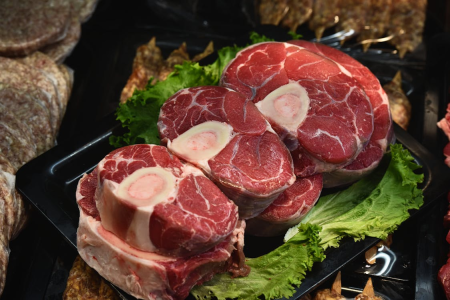Experts predict price hikes–here’s why your next meat purchase could cost more
By
Maan
- Replies 8
Australians could soon feel the impact of a growing crisis that’s unfolding across the country, one that threatens to hit both households and businesses alike.
As extreme weather continues to take its toll, experts warn that a major industry is facing disruptions that could have widespread consequences.
Here’s what’s happening—and why it might affect your next trip to the supermarket.
Australians were warned to brace for rising red meat prices as flooding in outback Queensland continued to devastate livestock numbers and disrupt supply chains.
The Queensland government reported that more than 100,000 cattle, sheep, and goats had either perished or gone missing due to the floods, with expectations that the number would climb.
John McKillop, independent chair of the Red Meat Advisory Council, said the extreme weather had severely affected cattle producers across western Queensland, parts of the Northern Territory, and northwest New South Wales.
‘Those producers won’t be able to access cattle (and) get them to market for some weeks, possibly months, due to the flooding,’ Mr McKillop said.
He explained that the reduced supply from the Channel Country region would force processors to compete for fewer cattle, inevitably pushing prices higher.
Despite the immediate challenges, he noted that the demand for store cattle would surge in the coming months.
‘For cattle that aren’t finished and aren’t ready for market, there’ll be a huge demand for them in two to three months time, as all this rain will produce a lot of feed that needs to be eaten,’ he said.
He remained optimistic about the industry’s recovery, saying: ‘People will get to their cattle eventually, those that don’t perish…and those cattle will eventually flow back into the market.’
He urged Australians to support local farmers, many of whom were struggling with contrasting weather conditions across the country.
‘The irony is that if you go down to…South Australia, Victoria, Tasmania…it’s dry down there,’ he said.
‘The shoe is very much on the other foot there, where there’s just no stock in sight.’
‘I really encourage people to get behind their local farmers and support them as much as they can.’
James Cook University Adjunct Professor Colin Dwyer shared that the pressure on meat prices mirrored what happened after Queensland’s devastating 2019 floods.
‘All the pressures are in place to see an increase in price…we need the ACCC to keep an eye on this to ensure there is no unnecessary price increase,’ he said.
Independent Food Distributors CEO Richard Forbes said road closures and transport disruptions could further affect the market.
‘That’s either going to be from a price perspective or it’s going to be from a food shortage perspective,’ he said.
In a previous story, experts warned about a growing scam that has been catching out unsuspecting Aussies looking for cheap meat deals.
As red meat prices continue to rise, scammers are taking advantage of the situation with fake offers that leave buyers out of pocket.
Read more to find out how to spot the warning signs and protect yourself.

With red meat prices set to rise, how will this impact your grocery shopping habits? Let us know your thoughts in the comments.
As extreme weather continues to take its toll, experts warn that a major industry is facing disruptions that could have widespread consequences.
Here’s what’s happening—and why it might affect your next trip to the supermarket.
Australians were warned to brace for rising red meat prices as flooding in outback Queensland continued to devastate livestock numbers and disrupt supply chains.
The Queensland government reported that more than 100,000 cattle, sheep, and goats had either perished or gone missing due to the floods, with expectations that the number would climb.
John McKillop, independent chair of the Red Meat Advisory Council, said the extreme weather had severely affected cattle producers across western Queensland, parts of the Northern Territory, and northwest New South Wales.
‘Those producers won’t be able to access cattle (and) get them to market for some weeks, possibly months, due to the flooding,’ Mr McKillop said.
He explained that the reduced supply from the Channel Country region would force processors to compete for fewer cattle, inevitably pushing prices higher.
Despite the immediate challenges, he noted that the demand for store cattle would surge in the coming months.
‘For cattle that aren’t finished and aren’t ready for market, there’ll be a huge demand for them in two to three months time, as all this rain will produce a lot of feed that needs to be eaten,’ he said.
He remained optimistic about the industry’s recovery, saying: ‘People will get to their cattle eventually, those that don’t perish…and those cattle will eventually flow back into the market.’
He urged Australians to support local farmers, many of whom were struggling with contrasting weather conditions across the country.
‘The irony is that if you go down to…South Australia, Victoria, Tasmania…it’s dry down there,’ he said.
‘The shoe is very much on the other foot there, where there’s just no stock in sight.’
‘I really encourage people to get behind their local farmers and support them as much as they can.’
James Cook University Adjunct Professor Colin Dwyer shared that the pressure on meat prices mirrored what happened after Queensland’s devastating 2019 floods.
‘All the pressures are in place to see an increase in price…we need the ACCC to keep an eye on this to ensure there is no unnecessary price increase,’ he said.
Independent Food Distributors CEO Richard Forbes said road closures and transport disruptions could further affect the market.
‘That’s either going to be from a price perspective or it’s going to be from a food shortage perspective,’ he said.
In a previous story, experts warned about a growing scam that has been catching out unsuspecting Aussies looking for cheap meat deals.
As red meat prices continue to rise, scammers are taking advantage of the situation with fake offers that leave buyers out of pocket.
Read more to find out how to spot the warning signs and protect yourself.
Key Takeaways
- Flooding in Queensland killed or displaced over 100,000 livestock, causing supply disruptions.
- Experts warned that limited cattle supply would drive red meat prices higher in the coming months.
- Demand for store cattle was expected to surge as improved pasture conditions followed the floods.
- Authorities were urged to monitor price increases while Australians were encouraged to support farmers.
With red meat prices set to rise, how will this impact your grocery shopping habits? Let us know your thoughts in the comments.








